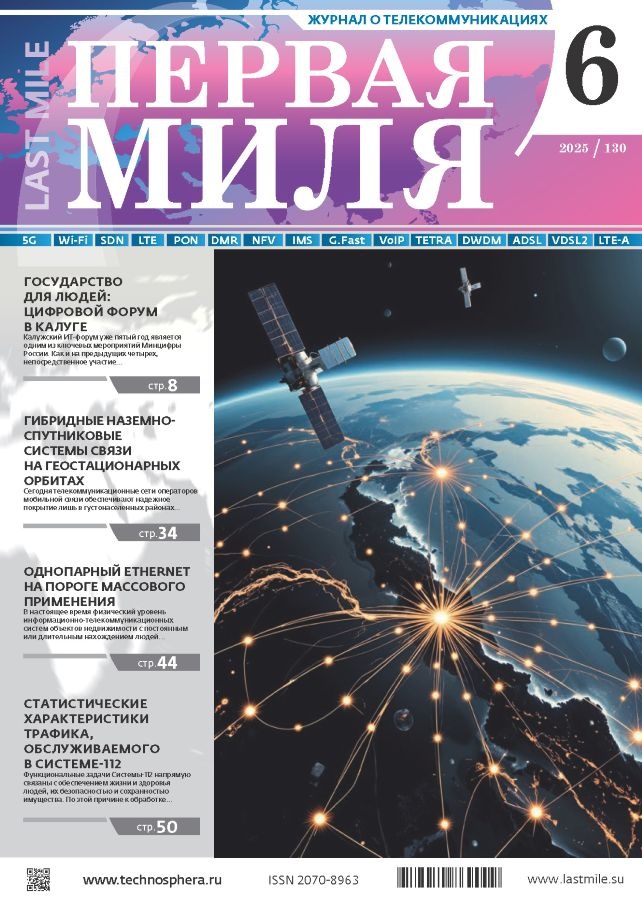Positioning in wireless local networks Wi-Fi standard IEEE 802.11az. Part 3. Influence of physical layer parameters
- Authors: Bagaev E.S.1, Fokin G.A.1
-
Affiliations:
- СПбГУТ им. проф. М.А. Бонч-Бруевича
- Issue: No 6 (2025)
- Pages: 22-32
- Section: WIRELESS COMMUNICATION
- URL: https://journals.eco-vector.com/2070-8963/article/view/692117
- DOI: https://doi.org/10.22184/2070-8963.2025.130.6.22.32
- ID: 692117
Cite item
Abstract
The work concludes a series dedicated to positioning in wireless local networks Wi-Fi standard IEEE 802.11az. The paper analyzes the physical layer parameters that contribute to achieving decimeter-level positioning accuracy in wireless local networks of the IEEE 802.11az standard in a multipath scenario. The impact of channel width, guard interval duration, and MIMO technology is shown. Qualitative analysis is accompanied by quantitative assessment using simulation modeling to study influence of parameters on positioning accuracy, considering previously reviewed models of IEEE 802.11az networks and multipath radio channels at the physical layer.
Full Text
About the authors
E. S. Bagaev
СПбГУТ им. проф. М.А. Бонч-Бруевича
Author for correspondence.
Email: bagaeve13@yandex.ru
аспирант
Russian FederationG. A. Fokin
СПбГУТ им. проф. М.А. Бонч-Бруевича
Email: grihafokin@gmail.com
д.т.н., проф.
Russian FederationReferences
- Фокин Г.А., Багаев Е.С., Мещеряков Д.Е. Позиционирование в беспроводных локальных сетях Wi-Fi стандарта IEEE 802.11az. Часть 1. Постановка задачи достижения дециметровой точности // ПЕРВАЯ МИЛЯ. 2025. № 1. С. 50–56.
- Фокин Г.А., Багаев Е.С. Позиционирование в беспроводных локальных сетях Wi-Fi стандарта IEEE 802.11az. Часть 2. Модель многолучевого радиоканала // ПЕРВАЯ МИЛЯ. 2025. № 5 (129). С. 26–34.
- Newly Released IEEE 802.11az Standard Improving Wi- Fi Location Accuracy is Set to Unleash a New Wave of Innovation. IEEE. [Электронный ресурс]. URL: https://standards.ieee.org/beyond-standards/newly-released-ieee-802-11az-standard-improving-wi-fi-location-accuracy-is-set-to-unleash-a-new-wave-of-innovation/ (дата обращения 15.06.2025).
- Picazo-Martínez P. et al. IEEE 802.11 az Indoor Positioning with mmWave // IEEE Communications Magazine. 2023. Vol. 62. No. 10. PP. 126–131.
- Тихвинский В., Девяткин Е., Смирнов Ю. Архитектура сетей 6G: принципы и особенности построения. Часть 1 // ПЕРВАЯ МИЛЯ. 2022. № 3 (103). С. 50–57.
- Тихвинский В., Девяткин Е., Белявский В., Смирнов Ю. Архитектура сетей 6G: принципы и особенности построения. Часть 2 // ПЕРВАЯ МИЛЯ. 2022. № 4 (104). С. 44–49.
- Famili A., Atalay T., Stavrou A. Unlocking the Potential of IEEE 802.11 az: A Deep Dive into Ranging Capabilities // 2025 International Conference on Computing, Networking and Communications (ICNC). IEEE, 2025. РР. 763–769.
- Jin J. Wireless Sensing Privacy Protection via Multi-Carrier Chirp Waveform // 2023 IEEE International Conference on Communications Workshops (ICC Workshops). IEEE, 2023. РР. 1112–1117.
- Leu P. Security of multicarrier time-of-flight ranging // Proceedings of the 37th Annual Computer Security Applications Conference. 2021. РР. 887–899.
- Zubow A. Wi-Fi Ranging under Interference // 2025 International Conference on Computing, Networking and Communications (ICNC). IEEE, 2025. РР. 533–537.
- Tung N., Huynh-The T., Tran T. Optimized Deep Networks for Indoor Position and Localization Based on IEEE P 802. 11az // 2024 International Conference on Advanced Technologies for Communications (ATC). IEEE, 2024. РР. 672–677.
- Chen C. Wi-Fi sensing based on IEEE 802.11 bf // IEEE Communications Magazine. 2022. Vol. 61. No. 1. РР. 121–127.
- Dogandzic A., Nehorai A. Cramer-Rao bounds for estimating range, velocity, and direction with an active array // IEEE transaction on Signal Processing. 2001. Vol. 49. No. 6. РР. 1122–1137.
- Witrisal K. Bandwidth scaling and diversity gain for ranging and positioning in dense multipath channels // IEEE Wireless Communications Letters. 2016. Vol. 5. No. 4. РР. 396–399.
- Soganci H., Gezici S., Poor H. Accurate positioning in ultra-wideband systems // IEEE Wireless Communications. 2011. Vol. 18. No. 2. РР. 19–27.
- Besson O., Stoica P. On frequency offset estimation for flat-fading channels // IEEE Communications Letters. 2002. Vol. 5. No. 10. РР. 402–404.
- Besson O., Stoica P. On parameter estimation of MIMO flat-fading channels with frequency offsets // IEEE Transactions on Signal Processing. 2003. V. 51. No. 3. РР. 602–613.
- IEEE 802.11ax Task Group. Channel Model Document [Электронный ресурс]. URL: https://www.ieee802.org/11/Reports/tgax_update.html (дата обращения 17.05.2025).
- Shellhammer S., Asterjadhi A., Sun Y. IEEE 802.11 ba: ultra-low power wake-up radio standard. John Wiley & Sons, 2023.
- Litwin L., Pugel M. The principles of OFDM // RF signal processing. 2001. Vol. 2. РР. 30–48.
- Zhou L. Toa estimation with cross correlation-based music algorithm for wireless location // 2014 Fourth International Conference on Communication Systems and Network Technologies. IEEE, 2014. РР. 862–865.
- Wang Z., Han Z., Liu K. A MIMO-OFDM channel estimation approach using time of arrivals // IEEE Transactions on Wireless Communications. 2005. Vol. 4. No. 3. РР. 1207–1213.
- Yabu T., Hara S. Impact of MIMO technique on TOA-based location estimation // 2009 IEEE 70th Vehicular Technology Conference Fall. IEEE, 2009. РР. 1–5.
- Chen Z. Multipath Assisted Wi-Fi Localization with a Single Access Point // IEEE Transactions on Mobile Computing. 2019. Vol. 20. No. 2. РР. 588–602.
- Han S. Indoor localization with a single Wi-Fi access point based on OFDM-MIMO // IEEE systems journal. 2018. Vol. 13. No. 1. РР. 964–972.
- Bharati S. Realization of MIMO channel model for spatial diversity with capacity and SNR multiplexing gains // arXiv preprint arXiv:2005.02124. 2020.
- Wen F. A survey on 5G massive MIMO localization // Digital Signal Processing. 2019. Vol. 94. РР. 21–28.
Supplementary files













